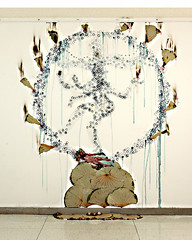A site specific drawing made directly on the walls of the gallery.
The drawing itself (made with the use of a spirograph, the 1960's
art making device for children) contains thousands of various size
small circles representing "The Cosmic Dancer", an ancient image
of Shiva, Lord of the Dance, dating back to prehistoric times
in India. The drawing was completed in three days.
Copyright © 2003 David Pohl
HOP | House of Pingting Archives
Nataraja
By Anu Kumar
Nataraja, "The Cosmic Dancer" is an ancient image of the divine dating back to prehistoric times in India. The earliest figurines are cast in stone and found amidst the ruins of the Indus Valley civilization (circa 4000-2800 C.E.) Later representations are cast in either bronze or iron and to be found in southern india from the time of the Chola Dynasty (800-1100 A.D.) The most famous of these is installed in the Siva temple at Chidambaram in Tamil Nadu where for centuries it has inspired the imagination and fervent devotion of pilgrims from all over India.
The image is deceptively simple at first glance. It reveals a sure-footed dancer-figure firmly holding down a crouched demon while the other is half-raised in a balancing pose. Four arms reach out expressively - the one on the left holds up a lighted torch from which issue burning flames that form a majestic aureole or a halo of fire around the figure, at once illuminating and encircling it. The right arm holds up a drum, the flying tassels of which indicate a rhythmic song in progress. The lower left hand is held up with palm out in a symbolic gesture, or "mudra", indicating and exhorting fearlessness. The lower right hand reaches gracefully across a lithe torso pointing down towards the delicate foot that is raised in movement. Here rest and salvation are assured to those seeking sincerely. The figure is androgynous with a dangling earring on the left side. Adorned with snakes as armlets, it holds the crescent moon like a jewel-clasp in the hair which is other-wise aflight in all directions in the frenzied ecstasy of dance.
Seen in the mystic imagination of poets from long ago, The Nataraja is a profound vision of the Absolute. This god is by no means aloof or hidden apart from creation in some transfixed realm. Rather He is supremely alive to a present moment in time that is charged with an extraordinary power and bliss. He is utterly joyful and unconstrained. The mystery of such joy lies in a paradox: to be alive is to die each moment and create anew. The Cosmic Dancer has an unstinting capacity to endure his own death and to leap forth into an unknown place where He will be emptied of every familar position or posession, claim or identity - indeed, of life itself. Through such a complete reversal and sacrafice, then, the Dancer attains a new life in an open ground that is now illuminated by the fires of self-knowledge and a triumphant self-awareness. This is the prize, the deepest mystery of His joy. The Nataraja is in complete union- is unity itself as living truth of action.
The sense of unity is expressed through a fine sensitivity to balance by the Cosmic Dancer. Rising above fear and ignorance, this deity knows that movement is an expansion from the limited into the unlimited, of matter into spirit, because He understands balance. Opposites abide in Him rather than exsisiting without: death and creation, lightness and dark, joy and pain, are but complementary poles to be conjoined through harmony and poise. The central axis of the Dancer's body is like a spinal column that knows an exquisite connection to all space and holds it together. Then the entire panorama of the world becomes a play or "lila"- a game, a dance, a spontaneous outflow of energy. The sacred is everywhere and in every step.
Sunday, January 17, 2010
Subscribe to:
Post Comments (Atom)








No comments:
Post a Comment